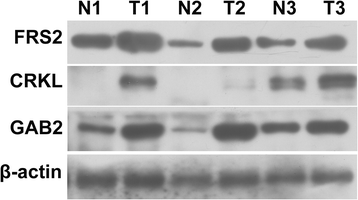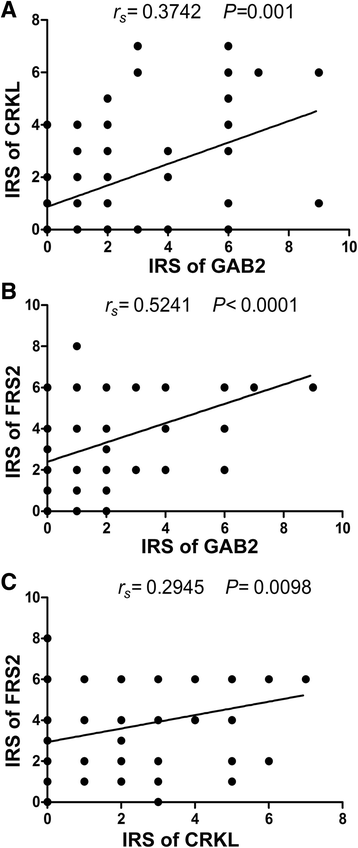Expression of signaling adaptor proteins predicts poor prognosis in pancreatic ductal adenocarcinoma
- PMID: 28558797
- PMCID: PMC5450263
- DOI: 10.1186/s13000-017-0633-4
Expression of signaling adaptor proteins predicts poor prognosis in pancreatic ductal adenocarcinoma
Abstract
Background: Adaptor proteins bridge the gap between cell surface receptors and their downstream signaling elements. The clinicopathological and prognostic values of adaptor proteins remain poorly understood. The purpose of the present study was to explore the expression and prognostic value of three adaptor proteins: GRB2-associated binding protein 2 (GAB2), CRK-like protein (CRKL) and fibroblast growth factor receptor substrate 2 (FRS2) in pancreatic ductal adenocarcinoma (PDAC).
Methods: The expression of GAB2, CRKL, and FRS2 in 77 formalin fixed paraffin embedded (FFPE) samples from 77 PDAC patients, along with three paired fresh PDAC and matched normal tissues from 3 PDAC patients was analyzed by immunohistochemistry and western blot, respectively. The association between the expression of the three proteins and the clinicopathological factors of PDAC was assessed by χ 2 test. The correlation between the expression levels of the three proteins was analyzed by Spearman rank correlation analyses; Kaplan-Meier survival analyses were also performed.
Results: IHC was successful in 75, 76, and 77 cases for GAB2, CRKL, and FRS2, respectively. Of which, the positive rate of GAB2, CRKL, and FRS2 protein expression was 40.00% (30/75), 53.95% (41/76) and 35.06% (27/77), respectively. The positive rate of GAB2, CRKL and FRS2 co-expression was 16.88% (13/77). Though there was no association between GAB2 expression, CRKL expression, FRS2 expression, GAB2/CRKL/FRS2 co-expression and the clinicopathological parameters of PDAC, positive correlations were observed between the expressions of the three proteins. Further, univariate survival analysis showed that positive expression of GAB2, CRKL and FRS2 and co-expression of GAB2/CRKL/FRS2 of PDAC predicted poor clinical outcomes, and multivariate survival analysis suggested that positive expression of GAB2 and positive co-expression of GAB2/CRKL/FRS2 were independent prognostic factors for disease-free survival (DFS) and overall survival (OS), respectively.
Conclusion: In conclusion, GAB2, CRKL, and FRS2 may be potential prognosticators and therapeutic targets for PDAC patients.
Keywords: CRKL; FRS2; GAB; Pancreatic ductal adenocarcinoma; Prognosis.
Figures




Similar articles
-
Ezrin protein overexpression predicts the poor prognosis of pancreatic ductal adenocarcinomas.Exp Mol Pathol. 2015 Feb;98(1):1-6. doi: 10.1016/j.yexmp.2014.11.003. Epub 2014 Nov 5. Exp Mol Pathol. 2015. PMID: 25445504
-
[Expression and clinical significance of Tspan 1 and Integrin α6 in human pancreatic ductal adenocarcinoma].Zhonghua Wai Ke Za Zhi. 2014 Oct;52(10):781-6. Zhonghua Wai Ke Za Zhi. 2014. PMID: 25573220 Chinese.
-
DEK protein overexpression predicts poor prognosis in pancreatic ductal adenocarcinoma.Oncol Rep. 2017 Feb;37(2):857-864. doi: 10.3892/or.2016.5302. Epub 2016 Dec 8. Oncol Rep. 2017. PMID: 27959420
-
Immune cell infiltrates as prognostic biomarkers in pancreatic ductal adenocarcinoma: a systematic review and meta-analysis.J Pathol Clin Res. 2021 Mar;7(2):99-112. doi: 10.1002/cjp2.192. Epub 2021 Jan 22. J Pathol Clin Res. 2021. PMID: 33481339 Free PMC article.
-
Oncogenic Signaling Adaptor Proteins.J Genet Genomics. 2015 Oct 20;42(10):521-529. doi: 10.1016/j.jgg.2015.09.001. Epub 2015 Sep 12. J Genet Genomics. 2015. PMID: 26554907 Free PMC article. Review.
Cited by
-
Quantitative assessment of glioblastoma phenotypes in vitro establishes cell migration as a robust readout of Crk and CrkL activity.J Biol Chem. 2021 Jan-Jun;296:100390. doi: 10.1016/j.jbc.2021.100390. Epub 2021 Feb 6. J Biol Chem. 2021. PMID: 33561443 Free PMC article.
-
Crk and CrkL as Therapeutic Targets for Cancer Treatment.Cells. 2021 Mar 27;10(4):739. doi: 10.3390/cells10040739. Cells. 2021. PMID: 33801580 Free PMC article. Review.
References
-
- Pettazzoni P, Viale A, Shah P, Carugo A, Ying H, Wang H, Genovese G, Seth S, Minelli R, Green T, et al. Genetic events that limit the efficacy of MEK and RTK inhibitor therapies in a mouse model of KRAS-driven pancreatic cancer. Cancer Res. 2015;75(6):1091–1101. doi: 10.1158/0008-5472.CAN-14-1854. - DOI - PMC - PubMed
MeSH terms
Substances
LinkOut - more resources
Full Text Sources
Other Literature Sources
Research Materials
Miscellaneous

